This is the first in a series of three articles discussing the benefits of yoga for masters swimmers.
“Masters swimmers are a very diverse bunch who have diverse reasons for doing what they’re doing,” says Amanda Heath, European record holder in the 200 meters breaststroke for the 60-64 age group.
“A common theme is that as we age we look for ways to maintain or reduce the decline of performance, which, unfortunately, accelerates the older you get.”
As we get older we don’t adapt to increases in workload in the same way as we did in our younger years. Our bodies tend to break down quicker and heal slower.
We all want to perform to the peak of our abilities, which becomes a greater challenge with demanding jobs, family and other commitments. The first priority for most is being in the water consistently and swimming for as many years as possible.
“Too much work in the pool leads to injuries, so we look for smarter ways to maintain our performance. In my view, yoga is a good option to fulfill this need.”
A swimming-specific yoga practice can benefit athletes of all ages. The two biggest differences for a masters swimmer is the time you have available to train and a shift in priorities as your body changes.
As we age it is not only our bodies, but our lifestyles that change as well. For that reason a yoga practice needs to be efficient and focused on the priorities that help prevent injury and perform in the water.
“Yoga meets anyone wherever they are at,” explains David Guthrie who holds multiple world records in breaststroke events in both the 50-54 and 55-59 year old age groups. “Age is not a factor. What’s great about yoga is no matter where you are, you can start and you will see improvement.
After working with masters swimmers as a coach for the last 28 years and as a yoga teacher for the last eight here are my top three priorities for a yoga for masters swimmers practice:
- Injury prevention
- Mobility
- Breathing
Although injury prevention is the number one priority mobility and breathing contribute to building a more resilient body. For that reason I will leave injury prevention to last.
Mobility – Working with Your Range of Motion
“I know that mobility is important, but I don’t have time for it.” This is a common refrain heard around the pool deck before and after masters swim practices. After years of ignoring this type of training your range of motion can become compromised.
This is when the phrase “use it or lose it” applies.
There are several variables that can affect healthy range of movement in a joint including injury, a lack of stretching or inactivity. Over time the soft tissues surrounding joints (muscle, ligaments, tendons, joint capsules and skin) can shorten and tighten if not stimulated in an appropriate way (1).
When you lose a healthy range of motion in a joint you leave yourself vulnerable to injury. Without this ability you stress surrounding tissues and joints in ways they are not meant to be.
Your performance can also suffer. Without appropriate range of motion developing effective technique can also become complicated.
For both efficiency of time and transferability to movement in the water masters swimmers should focus on four areas of the body when it comes to mobility; hips, shoulders, thoracic spine and ankles (2).
If you are thinking, “I am not flexible enough to do yoga.” You may be surprised. Most of us are not as supple as we once were, but as David Guthrie says yoga meets you where you are at.
In a yoga practice designed for masters swimmers you won’t be bending yourself into a pretzel you will be practicing functional mindful movement. The key is working with your range of motion. Allowing yourself to come into poses, not forcing yourself into poses.
When developing your range of motion there is one very important aspect to always include – the relationship between stability and mobility (this is something we will go over more when addressing injury prevention). Before beginning to increase your range of motion ensure joint stability and never sacrifice stability to increase your range of motion.
A great way to think about this is a term Tom Barton of Q Swim uses – developing length with strength. As you work on your range of motion ensure joint stability and focus on the ability to create force in your new range of motion.
The following three poses target the shoulders, thoracic spine and hips. When working with your current range of motion the first variation of these poses may not be possible for you to do. For each pose there are variations, which make them more accessible and will allow you to gain the same benefits.
All poses should be done with an appropriate warm up or within a yoga class or sequence. These three poses are appropriate to do after a practice holding each pose for approximately five breaths.
When practicing yoga follow the four keys to a strong, safe and effective yoga practice.
Yoga for Masters Swimmers – Cow Face Arms
Benefits:
- Shoulder Mobility
- Lengthening of the triceps
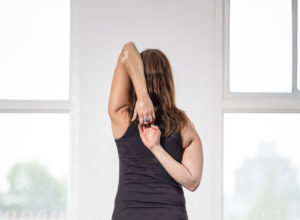
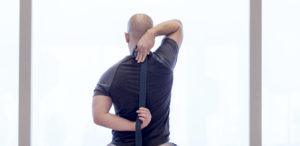
Cues:
- Lengthen your left arm up and overhead
- Bend your left elbow placing your hand on your spine
- Bring your right hand down towards your hip
- Bend your right elbow placing the back of your hand on your spine
- Bring your right and left hand towards each other
- Keep your neck long and your spine in a neutral position
- If your hands reach one another clasp the fingers
- As you do this open up through the front of the body feeling like the collar bones wide
Variation:
- Use a strap or replacement such as a belt
- Place the strap in the top hand and allow the length of the strap to follow the spine
- Hold onto the strap with the bottom hand and work with your range to bring the hands closer together
- As you do this ensure that you are keep the neck long, spine in a neutral position and the chest and shoulders open
Yoga for Masters Swimmers – Dragon
Benefits:
- Hip mobility
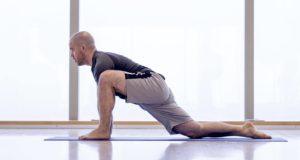
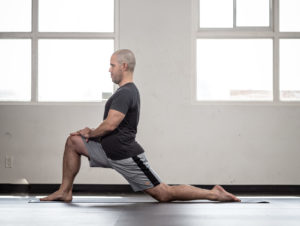

Cues:
- Come into a low lunge
- Heel toe your front foot to the outside of the mat
- Keep your knee directly over your ankle
- Square your hips
- Back your back knee up enough that you start to feel a stretch in your hip flexors
- Keep your hands to the inside of the front foot
- If you feel you need more sensation and your range allows you can come down onto the forearms
Variation One:
- Instead of having your hands on the floor you can use blocks to elevate the hands
Variation Two:
- Keep your foot in the center of the mat
- Ensuring the hips are square raise the upper body up placing the hands on your front thigh
Yoga for Masters Swimmers – Low Lunge Twist with Quad Stretch
Benefits:
- Hip and thoracic spine mobility
- Lengthening of the quadriceps
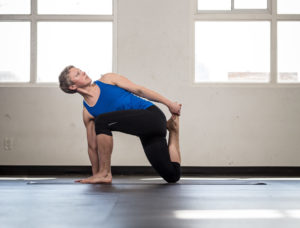
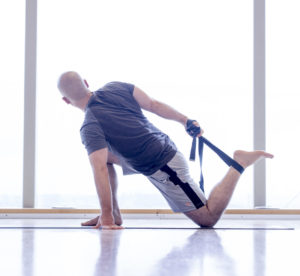
Cues:
- Come into a low lunge
- Ensure that your front knee is over your ankle
- On an inhale bring your back heel towards your seat
- Hold onto your back foot with the opposite hand
- Roll your shoulder open in the direction of the front leg rotating through your thoracic spine
Variation:
- Use a strap to reach your back foot
- Loop the strap around your back ankle or foot drawing the heel towards the seat
- Roll your shoulder open in the direction of the front leg rotating through your thoracic spine
…
The three poses above give you effective ways to work with your range of motion in specific areas of your body. The four short practices below (ranging from 11-20 minutes) give you an easy way to work a little more mobility into your busy lifestyle.
…
References:
- UC Davis Health, accessed 6 August 2020, https://health.ucdavis.edu/sportsmedicine/resources/flexibility_descriprion.html
- Mullen, J (2018). Swimming Science: Optimum Performance in the Water. Chicago: Ivy Press, p. 92.
…
This Yoga for Swimmers article is brought to you by Swimming-Specific Yoga the world’s top resource for online yoga classes and content designed for swimmers and multi-sport athletes.
…
Sign up here to receive the Swimming Specific Yoga newsletter
The newsletter includes information on how yoga can enhance both your swimming performance and your wellness.
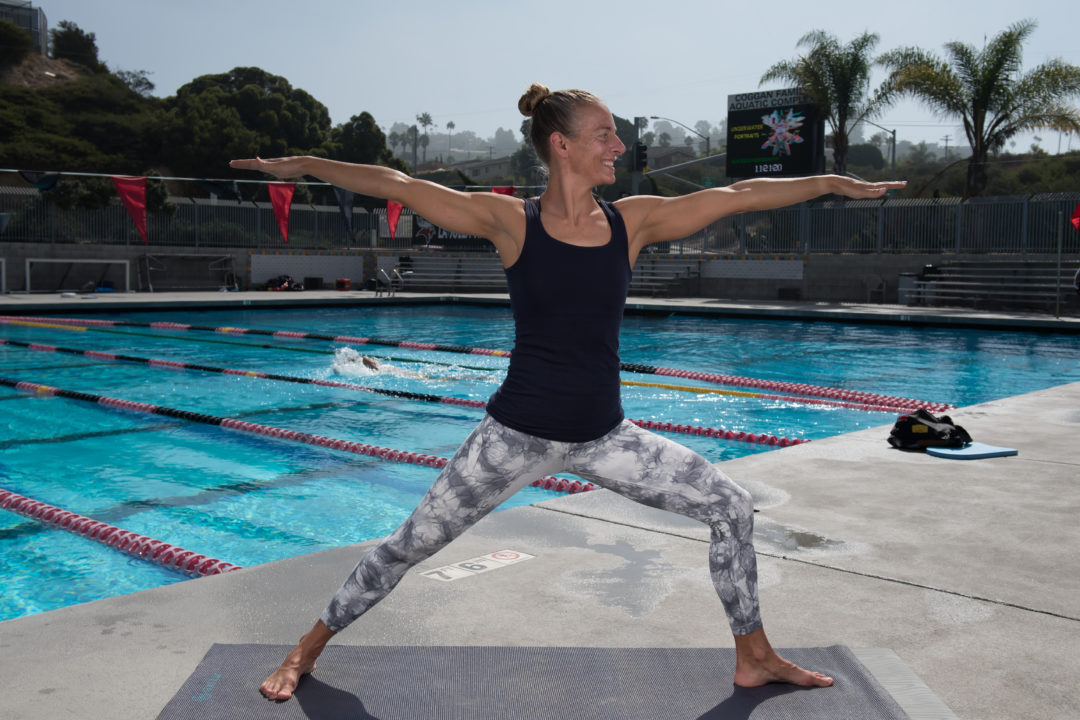

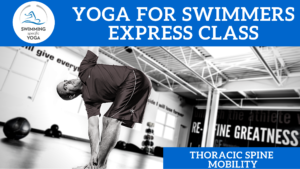
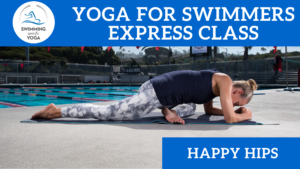
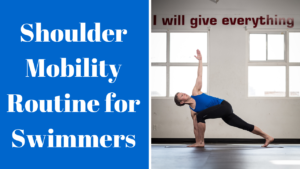
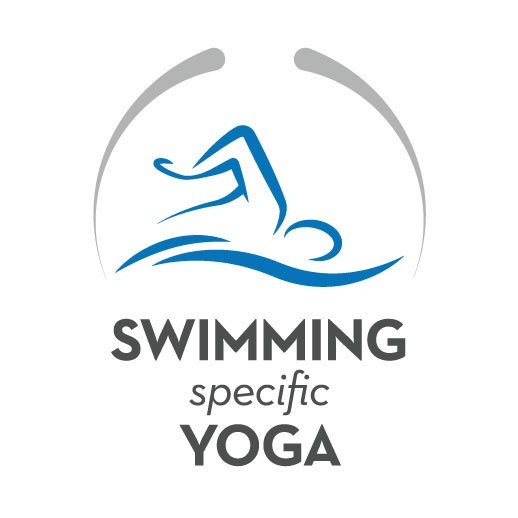
One of these days I am going to try swim-specific yoga. I haven’t yet because I like to move. I understand that prevention of injury in the pool is a primary reason for this yoga. But I already swim to prevent injuries – running injuries. And so far I have not been injured in the pool. Between working hard on my technique, swimming a lot of stroke, eating an anti-inflammatory diet and avoiding overtraining, I see no reason for any dryland training when I have access to a pool.
It is awesome to hear that you have been injury free and found a combination of activities and diet that also help you improve your performance. Stick with what is working for you.
I would love it if yoga was something that everyone wanted to include in their training regime because I feel the benefits it can bring are amazing. Having said that I have never and will never say that yoga is for everyone, because it is not.
If you decide to give it a shot let me know what you think.